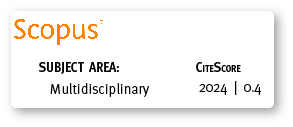La biodiversidad urbana como síntoma de una ciudad sostenible. Estudio de la zona del Yanuncay en Cuenca, Ecuador
DOI:
https://doi.org/10.18537/mskn.06.01.09Palabras clave:
biodiversidad urbana, ciudad sustentable, índice verde, Cuenca, avifaunaResumen
Al testear la situación de la biodiversidad urbana y los espacios verdes en la zona del Yanuncay de Cuenca (Ecuador), se pretendió revelar particularidades de la co-determinación entre la biodiversidad y las áreas verdes al interior de la ciudad. Se calcularon seis indicadores y tres índices que mostraron niveles alarmantemente bajos, que sugieren la necesidad de acciones inmediatas con el fin de recuperar la biodiversidad perdida. Por ejemplo, en el caso del indicador de la Permeabilidad del Suelo Público el 83.53% del suelo no es permeable; en cuanto a la Proximidad a Espacios Verdes el 98.82% del área de estudio no se aproxima al objetivo mínimo; en lo referente al cálculo de la Densidad de Árboles por Tramo de Calle el 98.83% de los tramos tienen arbolado insuficiente. Un aporte importante del trabajo es la construcción del Índice de Verde Urbano (IVU) que conjuga el indicador de Superficie Verde por Habitante con el de Proximidad Simultánea a Tres Tipos de Espacios Verdes, de este modo se puede tener una mirada tanto de la cantidad como de la cobertura e influencia, a distintas escalas, que estas áreas tienen sobre las personas. En este índice se constata que el 91.76% del área no cumple con el valor mínimo. Estos datos nos permiten afirmar que la ciudad actual y su producción de áreas verdes no contribuyen a la sostenibilidad ecológica y por ende a la biodiversidad urbana. Si no se proponen cambios urgentes al modelo de ciudad vigente, estos valores se volverán aún más alarmantes.
Descargas
Métricas
Citas
Astudillo Webster, P., D. Siddons, 2013. Avifauna de la ciudad de Santa Ana de los cuatro ríos de Cuenca, Ecuador. Cuenca: Comisión de Gestión Ambiental de Cuenca, Municipalidad de Cuenca y Universidad del Azuay.
Czech, B., P.R. Krausman, 1997. Distribution and causation of species endagerment in the United States. Science , 22, 116-121.
Fábos, J.G., R.L. Ryan, 2006. An introduction to greenway planning around the world. Landscape and Urban Plan., 76, 1-6.
Instituto Nazca de Investigaciones Marinas, EcoCiencia, Ministerio del Ambiente, The Nature Conservancy, Conservación Internacional, 2007. Prioridades de Conservación de la Biodiversidad en Ecuador Continental, 88 pp. Disponible en http://simce.ambiente.gob.ec/ sites/default/files/documentos/anny/Prioridades%20para%20la%20Conservaci%C3%B3n%20de%20Biodiversidad%20en%20el%20Ecuador%20continental.pdf.
Lovejoy, T., 1980. Changes in biological diversity (Vol. 2). Washington DC: Penguin Books.
MacArthur, R., E. Wilson, 1963. An equilibrium theory of insular zoogeography. Evolution, 17(4), 373-387.
Marzluff, J.M. (Ed.), T. Angell, 2005. Cultural coevolution: How the human bond with crows and ravens extends theory and raises new questions. Yale: New Havens University Press.
Müller, N., P. Werner, 2010. Urban biodiversity and the case for implementing the convention on biological diversity in towns and cities. En: Urban biodiversity and design. Oxford:Wiley-Blacwell.
Müller, N., M. Ignatieva, C. Nilon, P. Werner, W. Zipperer, 2012. Patterns and trends in urban biodiversity and landscape design. Urbanization, Biodiversity and Ecosystem Services: Challenges and Opportunities: A Global Assessment . Elmqvist, Th., M. Fragkias, J. Goodness, B. Güneralp, P.J. Marcotullio, R.I. McDonald, S. Parnell, M. Schewenius, M. Sendstad, K.C. Seto, C. Wilkinson. (Eds.). Springer Netherlands, 755 pp.
Myers, N., R.A. Mittermeier, C.G.B. Mittermeier, G.A. da Fonseca, J. Kent, 2000. Biodiversity hotspots for conservation priorities. Nature , 403, 853-858.
Ortega, R., I. McGregor (Eds.), 2013. Ecología urbana: Experiencias en América Latina, 130 pp. Disponible en http://www1.inecol.edu.mx/libro_ecologia_urbana/ecologia_urbana_ experiencias_en_america_latina.pdf.
Rueda, S. (coord.), 2007. Libro Verde Medio Ambiente Urbano. Tomo I. Ministerio de Medio Ambiente, 180 pp. Disponible en http://www.ecourbano.es/imag/libroverde.pdf.
Rueda, S. (coord.), 2008. Plan Especial de Indicadores de Sostenibilidad Ambiental de la Actividad Urbanística de Sevilla. Barcelona, 123 pp. Disponible en http://www.ecourbano.es/ imag/00%20DOCUMENTO%20ENTERO.pdf.
Rueda, S. (coord.), 2009. Plan de Indicadores de Sostenibilidad Urbana de Vitoria-Gasteiz.
Secretaría Nacional de la Administración Pública, 2013. Registro Oficial N. 138. Política Nacional de Gobernanza del Patrimonio Natural para la Sociedad del buen Vivir 2013-2017. Quito, Ecuador.
Tzoulas, K., P. James, 2010. Making biodiversity measures accesible to non-specialists: an innovative method for rapid assessment of urban biodiversity. Urban Ecosyst., 13, 113-127.
Ulloa Ulloa, C., P.M. Jørgensen, 1993. Arboles y arbustos de los Andes del Ecuador. Risskov, Denmark: Department of Systematics Botany, Aarhus University, 264 pp.
Wilkinson, C., M. Sendstad, S. Parnell, M. Schewenius, 2013. Urban governance of biodiversity and ecosystem services. Urbanization, Biodiversity and Ecosystem Services-Challenges and Opportunities: a Global Assessment. 539-587.
Zhang, W., 2008. A forecast analysis on world population and urbanization process. Environ. Dev. Sustain., 10(6), 717-730.
Descargas
Publicado
Cómo citar
Número
Sección
Licencia
Copyright © Autors. Creative Commons Attribution 4.0 License para cualquier artículo enviado a partir del 6 de junio de 2017. Para los manuscritos presentados anteriormente, se utilizó la licencia CC BY 3.0.
![]()
Usted es libre de:
 |
Compartir — compartir y redistribuir el material publicado en cualquier medio o formato. |
 |
Adaptar — combinar, transformar y construir sobre el material para cualquier propósito, incluso comercialmente. |
Bajo las siguientes condiciones:
 |
Atribución — Debe otorgar el crédito correspondiente, proporcionar un enlace a la licencia e indicar si se realizaron cambios. Puede hacerlo de cualquier manera razonable, pero de ninguna manera que sugiera que el licenciador lo respalda a usted o a su uso. |
| Sin restricciones adicionales: no puede aplicar términos legales o medidas tecnológicas que restrinjan legalmente a otros a hacer cualquier cosa que permita la licencia. |
Mayor información sobre este acuerdo de autoría y licencia, transferencia de derechos o solicitudes de reproducción, pueden ser consultados en este enlace.









